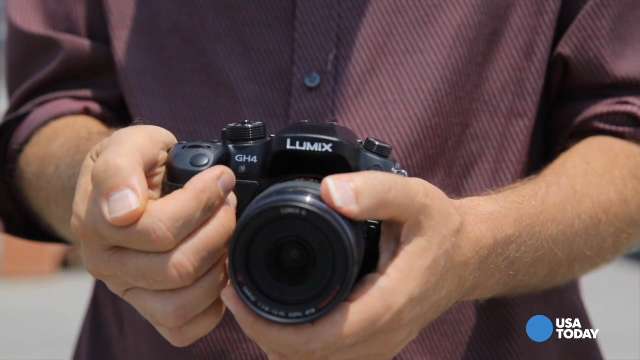Review: Panasonic GH4 for shooting great video

MANHATTAN BEACH, Calif. – For years, the Canon 5D Mark III has been considered the gold standard for those of us looking to shoot cinema quality high-def video.
Now there's a new contender: the $1,700 Panasonic GH4. This camera offers resolution that's four times that of the 5D – as it should, since it's the first consumer camera hybrid to offer a simple solution for 4K video.
So how does the GH4 stack up? Is it everything that's promised?
I've spent several weeks with the GH4 now, and here's my bottom line: amazing video quality, best in class, but in terms of usability, there's a learning curve. The multiple menus are a monster to learn.
I compared the 16 megapixel GH4 to the 22 megapixel 5D Mark III, which I've owned since it was first released in 2012.
The video on the GH4 trumps the 5D for sharper, crisper footage if shot in optimum light, like bright daylight. In low light, you'll need the 5D. The difference between the two was that striking.
That the 5D performs better in low light shouldn't be a shock. The full-frame image sensor on the 5D is nearly twice the size as that of the GH4, which uses the smaller, micro-four-thirds format developed by Panasonic and Olympus.
But do you really need a 4K camera? The new 4K "Ultra HD" TVs are still very pricey. And drool worthy, but few people have them. If you import your video footage into the computer, you really won't see much of a difference. You need to be looking at the 4K shots on a big TV.
But where shooting in 4K will come in handy now is the ability to crop. With so much extra resolution, you can really zoom in on things without losing any image quality.
Take a look at our shots in the accompanying video and you'll see.
The GH4 is about half the price of the Canon 5D, which sells for around $3,200, and while Canon has a wider lens selection available, Panasonic's offerings are growing and respectable.
The GH4 isn't the only 4K camera around. Sony recently introduced the $2,500 A7s, which shoots 4K on a larger, full-size image sensor, which would make it more suitable for low light work. There's a big drawback however – you can't shoot 4K video internally. The files are so big, you need to drag an external recorder.
#TalkingTech just got the A7s in for review, and will be back soon with a full report.
Readers: Are you shooting 4K yet? What's your experience? Let's chat about it on Twitter, where I'm @jeffersongraham.